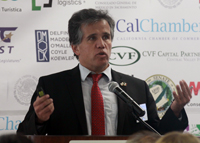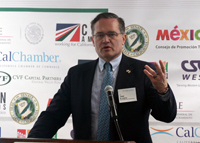Trade and investment opportunities in Mexico and California were the topic of discussion yesterday at the California Chamber of Commerce International Luncheon Forum as part of the VI California-Mexico Advocacy Day organized by Mexico’s Consulate General under the leadership of Gilberto Luna, acting consul general.
Less than one year after the California Gubernatorial Trade and Investment Mission to Mexico, trade relations between Mexico and California continue to flourish. Mexico remains California’s No. 1 export market, purchasing 14.6% of all California exports. California exports to Mexico amounted to $25.4 billion in 2014, a 6.3% increase from 2013.
VI California-Mexico Advocacy Day
The mission of VI California-Mexico Advocacy Day is to increase the relevance of Mexico’s relationship with California by raising awareness of the bilateral investment opportunities.
The objectives of the VI California-Mexico Advocacy Day are:
- To set the stage for a future business and investment mission to Mexico, in order to establish new contacts and articulate new investment opportunities to bolster common economic growth and prosperity.
- To encourage ties between Mexico’s financial and business experts and California state legislators, government officials, policy advisers and California pension fund managers.
- To expand the portfolio of bilateral investment opportunities to areas with great potential, such as border infrastructure, debt markets, stock markets and real estate.
Luncheon Speakers

Is North America Coming of Age as NAFTA Turns 21?
Dr. Pedro Javier Noyola, director general of Aklara and the NAFTA Fund, presented a brief perspective from Mexico about how the North American Free Trade Agreement (NAFTA) has benefited Mexico.
Mexico used to be a really, really closed economy, Dr. Noyola explained. Twenty years ago, the trade to Gross Domestic Product (GDP) ratio was about 20%; today it’s about 70%.
“And the big jump was due to NAFTA,” he said.
In the last 20 years, two-way trade in goods between Mexico and the United States increased dramatically, from $81.4 billion in 1993 to $534.5 billion in 2014. Mexico has remained the United States’ second largest export market since 1995, with a total value of $240.3 billion in 2014. Top export categories from the U.S. to Mexico included computer and electronic products, transportation equipment, chemicals, and non-electrical machinery.
“You see a statistical effect of NAFTA really changing the path of openness,” Dr. Noyola explained. “Exports, plus imports over GDP has tripled over the last 20 years. So Mexico has become open, and that’s very important because our tradable sector is disciplined by international prices.”
Dr. Noyola explained that there is “a ton of production sharing between the United States and Mexico.” This by far, he said, is the best indicator of NAFTA’s success for Mexico.
He illustrates this fact by explaining, if you take an average U.S. import from Mexico and say how much of the total cost of that import was produced in the United States, the total number is 40%. So 40% of total costs of imports from Mexico come from the United States. By comparison, the U.S. content of Chinese imports is 4%.
In closing, Dr. Noyola touched on the Trans-Pacific Partnership Agreement and Transatlantic Trade and Investment Partnership.
He said that NAFTA created a “huge competitive boost for its firms relative to the two other big regions of the world, and the challenge is to not erode that competitiveness as things are going on to the East and West.”
See Dr. Noyola’s PowerPoint Presentation

Increased Economic Integration Between California and Mexico
Dr. José Blanco, principal with Central Valley Fund Capital Partners, said that California and Mexico are becoming this “super regional economy,” with the combined GDPs amounting to $3.6 trillion.
“That’s like Germany, in terms of an economy,” Dr. Blanco explained. “We see those numbers becoming even more integrated.”
Looking at the level of trade dependencies, if one adds $25 billion for exports and the $41 billion for imports, that’s $66 billion of commerce between Mexico and California. “That’s a very important economic engine,” Dr. Blanco said. “There are about 700,000 jobs in California that depend on that commerce.”
California trade with Mexico has grown 341% in the last 20 years and is expected to grow 7%–10% annually.
Central Valley agriculture is also a very important source of commerce between the two regions, Dr. Blanco said. In 2014, California exported more than $664 million in agricultural products to Mexico.
In addition, California is the No. 1 tourism destination for Mexican citizens. In fact, Mexicans represented 50% of all international tourists to California.
See Dr. Blanco’s PowerPoint Presentation

Source Logistics: Build on California-Mexico Relationship
The final speaker, Marcelo Sada, chief executive officer of Source Logistics, explained how his company got started using California as a platform and evolved.
“California and Mexico are profoundly integrated as partners rather than competitors in the global economy,” he said.
Mexican companies are investing and creating job across the United States, Sada explained. He illustrated his point by showing a map of the United States and identifying that Mexican-owned companies operate more than 6,500 business establishments in the U.S. In fact, the U.S. is the main destination for Mexican Foreign Direct Investment (FDI), with Mexican companies investing more than $43 billion. Drilling down to the state level, Mexican companies operate 735 business establishments in California and provide 13,296 jobs.
Sada said that when he asked people what they thought of Mexico before, he got responses like, “cheap labor, unprepared labor and assembly.” Now, he explained, people need to think of Mexico differently because the country is known for highly qualified labor, high tech production. In fact Mexico is graduating around 130,000 engineers a year, which he thinks is more than the United States.
See Mr. Sada’s PowerPoint Presentation
Select Committee on California-Mexico Cooperation
CalChamber Policy Advocate Marti Fisher also participated in an informational hearing about coordinating economic partnerships and fostering economic devolvement with Mexico during a meeting of the Senate Select Committee on California-Mexico Cooperation, chaired by Senator Ben Hueso (D-San Diego) on May 5.
Fisher reiterated the CalChamber’s longtime support for promoting trade and investment between California and Mexico and the assistance it provided in last July’s trade and investment mission.
Trading Partner Portal: Mexico
For more information on California-Mexico trade, visit CalChamber’s Mexico Trading Partner Portal Page.
Staff Contact: Susanne T. Stirling

